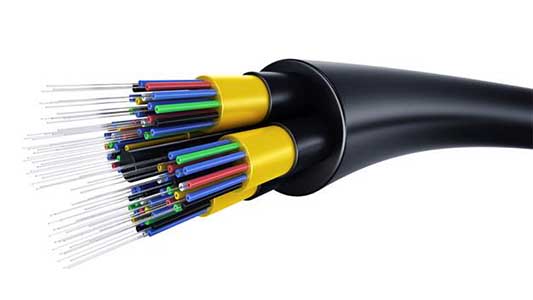The use of fiber optic cable across a large number of end-use industries will propel the growth of the global market. Advantages of fiber optic cable such as longer reach and high bandwidth connectivity are projected to have a profound impact on the growth structure of the market. Furthermore, the high preference in the telecommunication sector and data centers is anticipated to accelerate the growth prospects of the fiber optic cable market. Fiber optic cables are flexible devices that are designed for long-distance and high-performance telecommunication.
Understanding Fiber Optic Cables
At its core, a fiber optic cable is a hair-thin strand of glass or plastic that carries digital information in the form of light pulses. These cables consist of multiple layers, including a core, cladding, and outer buffer, designed to protect the delicate fiber from external elements. The core, where the light travels, has a higher refractive index than the cladding, ensuring that the light remains confined within the core through a process called total internal reflection.
How Do They Work?
The transmission of data through fiber optic cables relies on the principle of light propagation. When data is sent over a fiber optic cable, it is first converted into light pulses using a laser or light-emitting diode (LED) transmitter. These pulses of light travel through the core of the fiber, bouncing off the walls due to total internal reflection. The light signals are then detected at the receiving end of the cable, where they are converted back into electrical signals for processing.
Advantages of Fiber Optic Cables
The widespread adoption of fiber optic cables can be attributed to several key advantages they offer over traditional copper cables:
- High Bandwidth: Fiber optic cables have a much higher bandwidth compared to copper cables, allowing for the transmission of large amounts of data over long distances without signal degradation.
- Low Latency: Light travels through fiber optic cables at close to the speed of light, resulting in minimal latency. This makes fiber optic cables ideal for applications that require real-time communication, such as online gaming and video conferencing.
- Immunity to Electromagnetic Interference (EMI): Unlike copper cables, fiber optic cables are immune to EMI, making them highly reliable in environments where electromagnetic interference is prevalent, such as industrial settings or areas with high electrical noise.
- Security: Fiber optic cables are inherently secure, as they do not emit electromagnetic signals that can be intercepted or tapped into. This makes them ideal for transmitting sensitive information, such as financial data or government communications.
- Long-Distance Transmission: Fiber optic cables can transmit data over much longer distances than copper cables without the need for signal boosters or repeaters. This makes them well-suited for long-haul communication links, such as undersea cables connecting continents.
- Lightweight and Space-Efficient: Fiber optic cables are thinner and lighter than copper cables, allowing for easier installation and requiring less physical space in crowded cable ducts or conduit systems.
Applications of Fiber Optic Cables
The versatility and reliability of fiber optic cables have led to their widespread adoption across various industries and applications:
- Telecommunications: Fiber optic cables form the backbone of telecommunications networks, enabling high-speed internet access, voice calls, and video streaming services.
- Data Centers: Fiber optic cables are used extensively within data centers to interconnect servers, storage devices, and networking equipment, facilitating rapid data transfer and minimizing latency.
- Broadcasting and Entertainment: Fiber optic cables are used to transmit television signals, enabling the distribution of high-definition video content to viewers around the world.
- Medical Imaging: Fiber optic cables play a crucial role in medical imaging technologies such as endoscopy and laparoscopy, allowing for minimally invasive procedures and precise visualization of internal organs.
- Industrial Automation: Fiber optic cables are used in industrial automation systems to transmit control signals and sensor data, enabling real-time monitoring and control of manufacturing processes.
Key players operating in the global fiber optic cable market are:
Corning Inc., Prysmian Group, HTGD, Furukawa Electric Co., Ltd., Yangtze Optical Fibre and Cable (YOFC), Sumitomo Electric Lightwave Corp., Tongding Interconnection Information Co. Ltd, CommScope, and Sterlite Tech.
The Future of Fiber Optic Communication
As technology continues to evolve, fiber optic communication is poised to play an even greater role in shaping the future of communication. Emerging technologies such as 5G wireless networks, Internet of Things (IoT) devices, and smart cities will rely heavily on fiber optic infrastructure to support their bandwidth-intensive applications. Moreover, ongoing research in materials science and photonics is driving the development of next-generation fiber optic cables capable of even higher data rates and longer transmission distances.
These insights are based on a report on Fiber Optic Cable Market by Transparency Market Research












